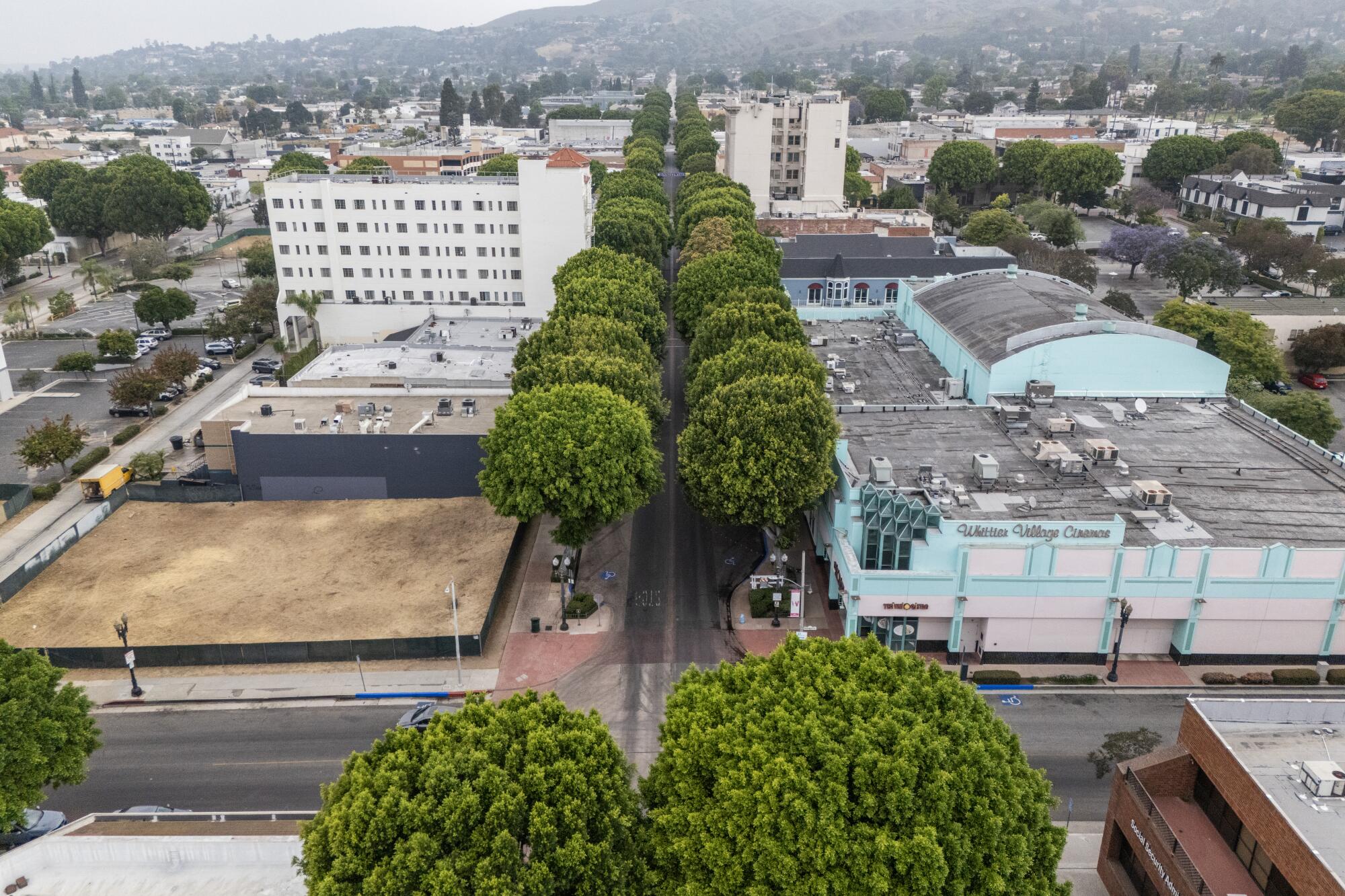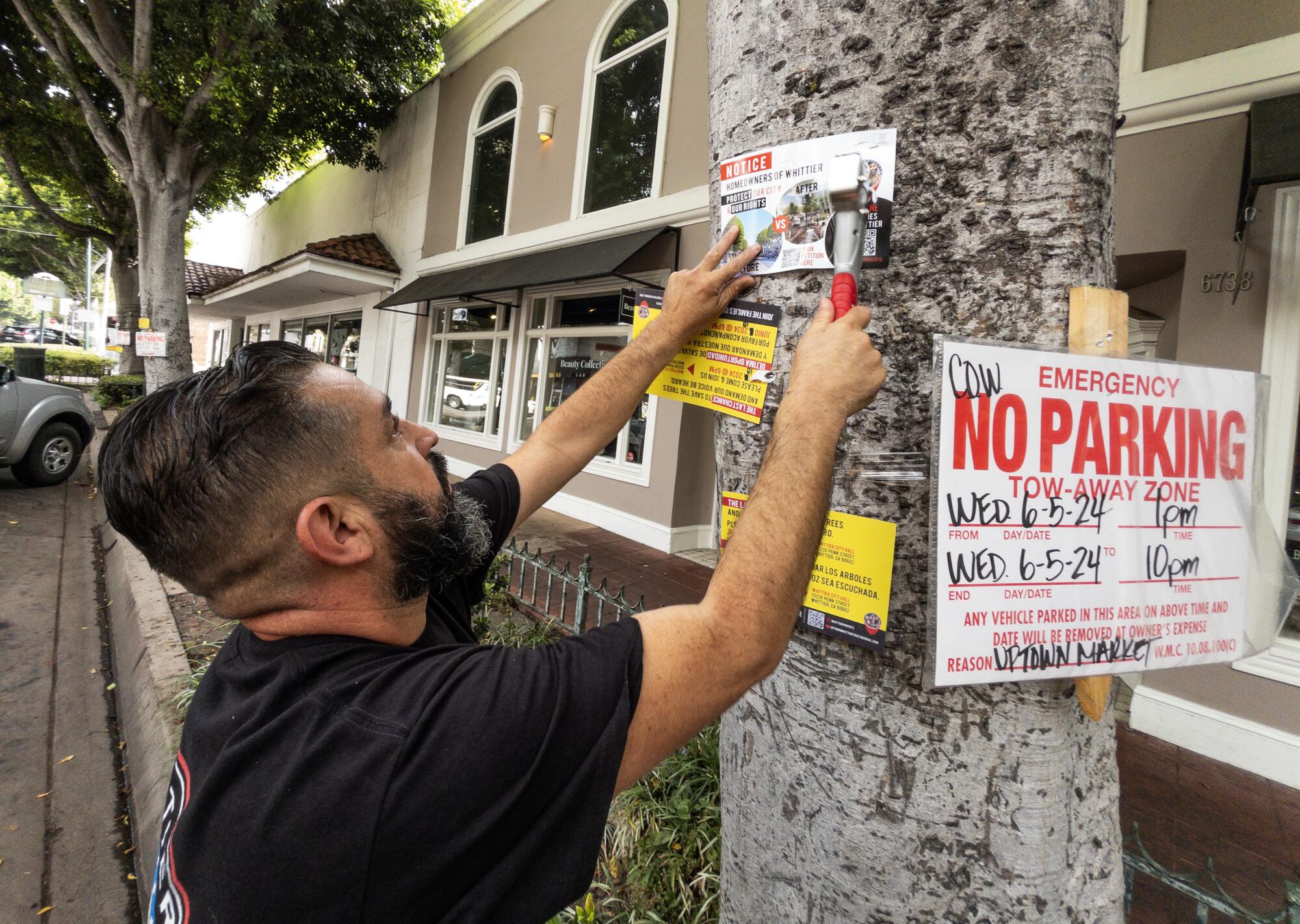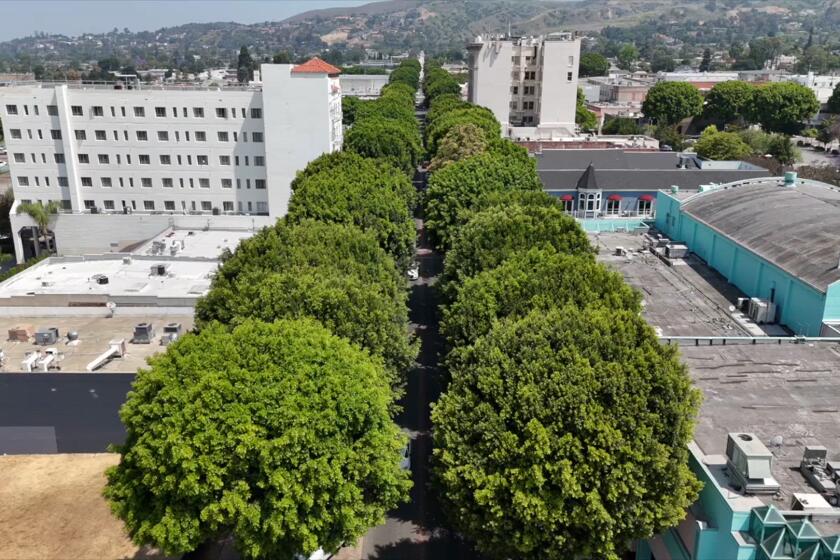
- Share via
- The lawsuit alleges the city of Whittier failed to carry out required environmental review when it approved a revised business district refresh that entails the removal of more than 100 trees.
- City officials declined to comment on the lawsuit but have insisted that it is impossible to preserve trees in the project area, including 83 ficus.
- The city’s plan has spurred outrage and divided the community.
The fight to save Whittier’s trees has grown new roots.
A preservation group has sued the southeastern Los Angeles County city over its plan to raze more than 100 trees as part of a redesign of its commercial center, marking the latest flashpoint in a roughly yearlong battle over the canopy’s fate.
Filed earlier this month in L.A County Superior Court, the lawsuit brought by the Whittier Conservancy alleges the city did not conduct the necessary environmental review as information concerning the $20-million Greenleaf Promenade came to light, including its potential effects on greenhouse gas capture and available shade.
The Whittier City Council voted on Tuesday night to move forward with razing 83 ficus trees as part of a redesign of its commercial center despite backlash.
Whittier City Council members voted 3 to 1 in June to proceed with the plan, billed as a means to boost business and enhance walkability in the Uptown area, with a few changes to a project initially approved last year.
City officials maintain that construction required by the project makes it impossible to save 83 ficus and other trees that line a three-block stretch of Greenleaf Avenue slated for redevelopment, which has led to public backlash and calls for reconsideration.
Several “study sessions” were held to examine the plan for the trees after the project’s approval last December, and some in the community hoped to hammer out an alternative approach.
Whittier Conservancy President Mary Gorman-Sullens said the nonprofit “resorted to litigation only after attempts of reaching reasonable, workable compromise were rejected from the city.”
“You can keep the canopy and still upgrade the business district while doing so,” she added. “And we stay committed to that approach.”
Whittier Mayor Pro Tem Cathy Warner cited sidewalk access for disabled people as one of the reasons why the trees have to go. Ficus tree roots can lift and split concrete walkways, potentially impeding pedestrian movement.
“I wish there was another solution — a viable solution — to deal with the [Americans with Disabilities Act] issues and to improve Uptown,” Warner said.
At the heart of the lawsuit is the claim that the city of Whittier violated the California Environmental Quality Act, or CEQA, a state law that requires public agencies to evaluate the potential environmental impacts of proposed projects and identify ways to avoid or lessen those impacts.
The Greenleaf Promenade grew out of a smaller pilot project that was scuttled by the pandemic, according to city officials. Estimated to cost $3.8 million, the one-block Gardens of Uptown differed in a way some see as crucial: It preserved clusters of trees.
The initial plan called for removing 22 trees. The latest iteration of the project calls for felling 108 trees rooted along Greenleaf Avenue, between Wardman and Hadley streets, and planting 118 smaller trees in the area.
At a June meeting, the City Council approved modifications to the project, including replacing trees slated for removal with larger trees than previously envisioned and adding shade structures to cover the sidewalk. The changes appeared to respond to concerns about how razing the trees could reduce shade and carbon capture and storage.
According to an April project report, there would be a significant drop in carbon sequestration the first year after the current canopy was replaced, with the level expected to break even in 24 years, based on the plan before it was amended.
The lawsuit states that the revelation concerning the drop in carbon sequestration necessitates environmental review, and that the modifications — described as attempts to mitigate what’s known as the urban heat island effect — also require analysis under CEQA.
Shortly before the June meeting, the city’s public works director told the conservancy that a plan to replace an aging water main along Greenleaf would require trees to be removed. The suit claims that the water main project was improperly segmented from the promenade.
The suit also alleges that the final approved project lacks specifics and allows for possible changes, which it identifies as another CEQA violation, and that the city flouted local laws governing tree removal and historic preservation.
“We feel there’s been a lack of full transparency on what exactly the motivations and the actual plans for this area is,” said Amy Minteer, an attorney representing the Whittier Conservancy.
The suit calls for a halt to the project as the city complies with its obligations under state and local law.

Other cities have battled in the courts over the preservation of ficus and other trees.
Beverly Hills clear-cut more than 50 ficus trees as part of a sidewalk renovation project before a judge ordered the city to stop via a preliminary injunction. The city settled the suit and is in the process of completing an environmental impact report for the project, according to Jamie T. Hall, an attorney representing tree advocates in the case.
Hall is also involved with an ongoing case against the city of Burbank concerning the removal of more than 70 pine trees.
“All across California cities are getting push back from concerned citizens who refuse to accept clear-cutting their urban forest,” Hall said in a statement. “It’s hard for many people to do much about climate change, but they know intuitively that removing mature trees causes great harm to the environment.”
Whittier Mayor Pro Tem Warner said she respects the conservancy’s views, though she disagrees with them.
“They are seeking what they believe to be is the right answer, the right outcome, according to their perspectives,” she said. “And I think it’s just a matter of we have different perspectives on how we interpret different bits and pieces of information.”
In a statement, City Manager Brian Saeki declined to comment on the litigation but described the promenade as the centerpiece of a decades-long effort to support local businesses and make the Uptown area more pedestrian friendly. The redesign includes wider sidewalks, outdoor dining, gathering spaces, street furniture and decorative lighting.

Both opponents and supporters of the latest version of the plan tend to agree the area in the heart of the city, last updated in the 1980s, could use a makeover.
Whittier resident Conny McCormack said a group she launched that opposes the tree removal was out “in full force” at a recent Christmas parade gathering signatures for a petition. Nearly 6,800 people have signed it.
McCormack said getting people on board was easy: “They were so outraged ... sitting under the trees on their favorite street, on Greenleaf.”
Some blame the trees for sidewalk and plumbing issues; others relish their shade. But a redevelopment plan for Uptown Whittier would remove the ficus canopy along Greenleaf Avenue.
Warner, however, said many residents in one-on-one conversations and via email have expressed their support for the promenade.
She said they ask, “When are you going to get this done? Why is it taking so long?”










